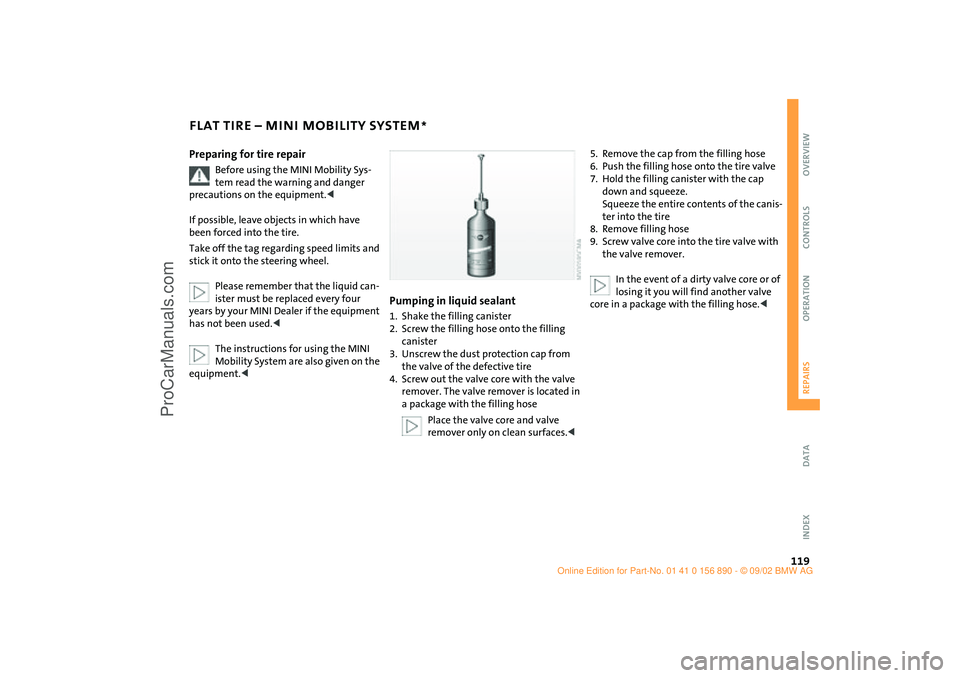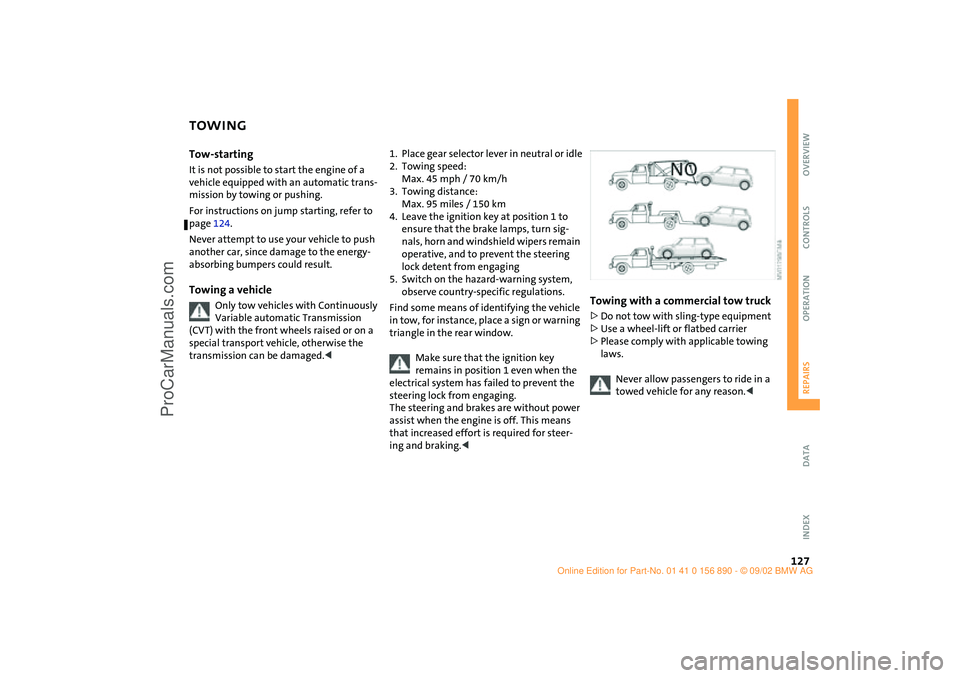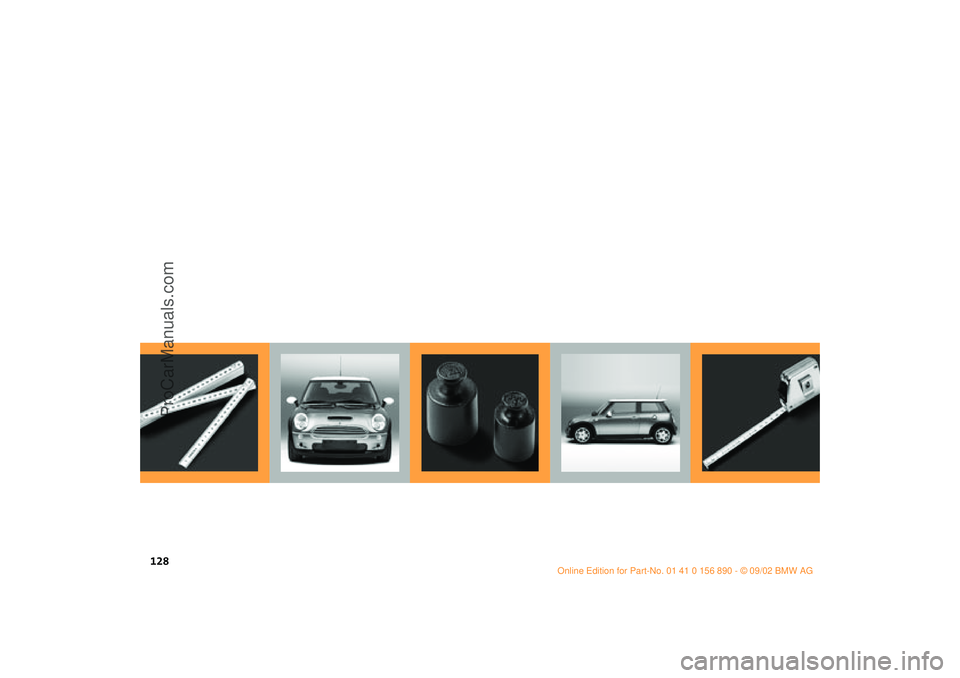MINI COOPER 2003 Owners Manual
Manufacturer: MINI, Model Year: 2003, Model line: COOPER, Model: MINI COOPER 2003Pages: 148, PDF Size: 3.17 MB
Page 121 of 148

119
OVERVIEW REPAIRSOPERATION CONTROLS DATA INDEX
FLAT TIRE – MINI MOBILITY SYSTEM
*
Preparing for tire repair
Before using the MINI Mobility Sys-
tem read the warning and danger
precautions on the equipment.<
If possible, leave objects in which have
been forced into the tire.
Take off the tag regarding speed limits and
stick it onto the steering wheel.
Please remember that the liquid can-
ister must be replaced every four
years by your MINI Dealer if the equipment
has not been used.<
The instructions for using the MINI
Mobility System are also given on the
equipment.<
Pumping in liquid sealant1. Shake the filling canister
2. Screw the filling hose onto the filling
canister
3. Unscrew the dust protection cap from
the valve of the defective tire
4. Screw out the valve core with the valve
remover. The valve remover is located in
a package with the filling hose
Place the valve core and valve
remover only on clean surfaces.<
5. Remove the cap from the filling hose
6. Push the filling hose onto the tire valve
7. Hold the filling canister with the cap
down and squeeze.
Squeeze the entire contents of the canis-
ter into the tire
8. Remove filling hose
9. Screw valve core into the tire valve with
the valve remover.
In the event of a dirty valve core or of
losing it you will find another valve
core in a package with the filling hose.<
ba.book Seite 119 Montag, 5. August 2002 8:09 20
ProCarManuals.com
Page 122 of 148

120
FLAT TIRE – MINI MOBILITY SYSTEM
*
Reinflating the tire
1. Screw hose 1 with manometer onto the
tire valve
2. Connect plug 3 to the cigarette lighter
socket in the vehicle interior, see
page 73
3. Ignition key in position 1:
Turn on compressor 2
4. Pump up the tires to at least 26.1 psi /
180 kPa, but not to more than 36.2 psi /
250 kPa.
To check the current air pressure, shut
off the device for a short time
Do not run the compressor for
longer than 6 minutes, otherwise
the device will overheat and possibly be
damaged.<
If an air pressure of 26.1 psi /
180 kPa cannot be reached, drive
back and forth about 35 ft / 10 m so that
the liquid sealant is distributed in the
tire. Afterwards repeat the procedure.
If an air pressure of 26.1 psi / 180 kPa is
still not reached, the tire is too badly
damaged. Please contact the nearest
MINI Dealer.<
5. Turn off compressor 2
6. Unscrew hose 1 from the tire valve
7. Store the MINI Mobility System back in
the vehicle.
Distributing liquid sealantImmediately drive for 10 minutes, so that
the liquid sealant is uniformly distributed.
Do not exceed a speed of 40 mph /
60 km/h).
If possible do not drive at a speed lower
than 10 mph / 20 km/h. Stop at a suitable
location.<
ba.book Seite 120 Montag, 5. August 2002 8:09 20
ProCarManuals.com
Page 123 of 148

121
OVERVIEW REPAIRSOPERATION CONTROLS DATA INDEX
FLAT TIRE – MINI MOBILITY SYSTEM
*
Checking tire inflation pressure
1. After driving for 10 minutes:
Screw hose with manometer back onto
the tire valve
2. Check tire pressure
The tire inflation pressure must be
at least 18.8 psi / 130 kPa.
If it is not, do not continue driving.<
If 18.8 psi / 130 kPa are displayed:
3. Ignition key position 1:
Turn on compressor 2. Correct tire infla-
tion pressure to the prescribed value, see
tire inflation pressure table, page 86
4. Replace the tire as soon as possible.
The use of the MINI Mobility System
may be ineffective with tire damage
larger than approx.
3/16 in / 4 mm. Please
contact the nearest MINI Dealer if the tire
cannot be made drivable with the MINI
Mobility System.<
Driving on
Do not exceed the permitted maxi-
mum speed of 50 mph / 80 km/h,
otherwise an accident could happen.<
Replace the defective tire as soon as
possible and have the new wheel/tire
assembly balanced.
Have the MINI Mobility System refilled.
Please contact your MINI Dealer. They pro-
vide advice if you wish to replace the tires
on your MINI or re-equip from summer to
winter tires or vice versa.<
Tire change setYour MINI is additionally equipped with a
tire change set. This is located in the MINI
COOPER in the cargo area under the floor
mat.
When changing a tire, always observe the
safety measures on page 112, and follow
the procedure described on page 114 ff.
In case of a flat tire the tire change
set is not necessary due to the avail-
ability of the MINI Mobility System.<
ba.book Seite 121 Montag, 5. August 2002 8:09 20
ProCarManuals.com
Page 124 of 148

122
BATTERYLocation in the MINI COOPERThe battery is located in the engine com-
partment.
Exact location, see page 92.Location in the MINI COOPER SThe battery is located in the cargo area
under the floor mat.
Battery careThe battery is absolutely maintenance-free,
that is, the original electrolyte will normally
last for the service life of the battery under
moderate climatic conditions.
For all questions regarding the bat-
tery, please consult your MINI
Dealer.<
Charging the battery Only charge the battery in the vehicle via
the terminals in the engine compartment
with the engine switched off, see "Jump-
starting" on page 124.
Whenever working on the electrical
system, disconnect the cable from
the negative terminal of the battery. Fail-
ure to do this could result in fire hazards or
injury due to short circuits.
point or your MINI Dealer. Maintain
the battery in an upright position for trans-
port and storage. Secure the battery to pre-
vent it from tilting during transport.<
ba.book Seite 122 Montag, 5. August 2002 8:09 20
ProCarManuals.com
Page 125 of 148

123
OVERVIEW REPAIRSOPERATION CONTROLS DATA INDEX
FUSESIf an electrical device fails, switch it off and
check the fuse.
Plastic tweezers that you can use to pull
fuses out of their sockets can be found in
the fuse box in the vehicle interior, see next
column.In the engine compartmentIn the MINI COOPER on the right next to the
battery.
In the MINI COOPER S on the right next to
the air filter box.
Open the cover panel of the fuse box. To do
so, press the clip fastener.
In the vehicle interiorOn the left side of the footwell in the side
trim panel.
Open the cover panel of the fuse box. To do
so, press the fastener.
Do not attempt to repair a blown fuse
or replace it with a fuse of a different
color or Ampere rating. To do this could
cause a fire in the vehicle resulting from a
circuit overload.<
If a fuse blows a second time, have
the cause of the damage rectified by
your MINI Dealer.<
ba.book Seite 123 Montag, 5. August 2002 8:09 20
ProCarManuals.com
Page 126 of 148

124
WARNING TRIANGLE
*
FIRST-AID KIT
*
JUMP-STARTING
The warning triangle is located beneath the
luggage compartment cover.
Comply with legal requirements
requiring you to carry a hazard warn-
ing triangle in the vehicle.<
The first-aid kit is located on the left in the
luggage compartment, behind the side
trim panel.
Some articles in the first-aid kit are
perishable. For this reason, check the
expiration dates of each of the items regu-
larly, and replace any whose expiration
dates have passed. Source: any pharmacy.
Comply with legislation requiring you to
carry a first-aid kit in the vehicle.<
Do not use spray starter fluids to start
the engine.<
When your battery is discharged, you can
use two jumper cables to start your vehicle
with power from the battery in a second
vehicle. Correspondingly you can help start
another vehicle. Only use jumper cables
with fully insulated handles on the termi-
nal clamps.
Do not touch live wiring and cables
on a running engine. There is a risk of
fatal injury if you do this. Carefully observe
the following instructions to avoid personal
injury and/or damage to either vehicle or
both vehicles.<
ba.book Seite 124 Montag, 5. August 2002 8:09 20
ProCarManuals.com
Page 127 of 148

125
OVERVIEW REPAIRSOPERATION CONTROLS DATA INDEX
JUMP-STARTINGPreparing for jump-starting1. Check whether the battery of the sup-
port vehicle has 12 Volts and approxi-
mately the same capacity – measured in
Ah, printed on the battery
2. Switch off the engine of the support
vehicle
3. Switch off any electrical systems and
components in both vehicles – except
for the hazard warning flashers of the
support vehicle.
>Do not disconnect the discharged bat-
tery from the vehicle electrical system
>Make certain that there is no contact
between the bodywork of the two
vehicles – short circuit hazard!
4. With the battery of the MINI COOPER,
remove the cover panel. To do so, press
both clips at the same time
or
with the MINI COOPER S, open the cover
of the positive terminal connection for
jump-starting
*, see arrow 1.
Connect the jumper cables
Adhere to the sequence also when
providing support for other vehicles;
failure to observe this procedure can lead
to sparks at the terminals and pose an
injury hazard.<
1. On the MINI COOPER S, the positive ter-
minal connection for jump-starting, see
arrow 1, functions as the positive bat-
tery terminal.
Make a connection with the "+" jumper
cable between the positive terminal of
the discharged battery and the positive
terminal of the support battery
2. Use the second, "–" jumper cable to set
up the connection between the negative
terminals of both vehicles.
To do so:
>Connect one terminal clamp to the
negative terminal and/or to an engine
or body ground of the support vehicle
>Connect the second terminal clamp to
the negative terminal of the battery
and/or to an engine or body ground of
the vehicle to be started. For the MINI,
see arrow 2.
Performing the jump-start1. Start the engine of the vehicle providing
the current and allow to run at a fast idle
speed for several minutes
2. Start the engine on the vehicle with the
discharged battery in the usual manner.
>If the first start attempt is not suc-
cessful, wait a few minutes before
another attempt in order to allow the
discharged battery to recharge
On the MINI:
Before disconnecting the jumper
cables, switch on the lighting, rear window
defroster and the highest blower speed as
well as the engine for at least approx.
10 seconds to prevent a voltage surge from
the regulator to the electrical systems and
components.<
3. Then disconnect the jumper cables in
the reverse order.
If necessary have the battery checked and
completely charged at a MINI Dealer.
ba.book Seite 125 Montag, 5. August 2002 8:09 20
ProCarManuals.com
Page 128 of 148

126
TOWINGFor towing, use either a tow bar or a nylon
rope or nylon belts that prevent sudden
jerking movements.Tow fittingThe screw-in tow fitting is stored in the
onboard tool kit; be sure that it remains in
the vehicle at all times. This fitting is
designed for installation in the tow sockets
located at the front and rear of the vehicle.
It is intended for towing on paved road sur-
faces only.
Access to tow socketsUse a suitable object – e.g. credit card,
screwdriver – to press out the covers from
the recess.
Firmly screw in the towing eyelet
until it stops. If this is not done, the
threads could be damaged.
Never attach tie-down hooks, chains,
straps, or tow hooks to tie rods, control
arms, or any other part of the vehicle sus-
pension, as severe damage to these compo-
nents will occur, possibly leading to acci-
dents.<
Avoid staggered towing and be care-
ful that the towing rope is in tight
tension before starting to drive the vehicle
that is towing.<
Tow barsIf the tow fittings of the two vehicles are
not directly opposite one another, please
note:
>Clearance and maneuvering capability
will be strictly limited in corners
>The inclination of the tow bar generates
lateral force – critical above all if the road
surface is slippery.
Do not tow a vehicle that is heavier
than the towing vehicle, otherwise it
will no longer be possible to control the
vehicle's response.<
ba.book Seite 126 Montag, 5. August 2002 8:09 20
ProCarManuals.com
Page 129 of 148

127
OVERVIEW REPAIRSOPERATION CONTROLS DATA INDEX
TOWINGTow-startingIt is not possible to start the engine of a
vehicle equipped with an automatic trans-
mission by towing or pushing.
For instructions on jump starting, refer to
page 124.
Never attempt to use your vehicle to push
another car, since damage to the energy-
absorbing bumpers could result.Towing a vehicle
Only tow vehicles with Continuously
Variable automatic Transmission
(CVT) with the front wheels raised or on a
special transport vehicle, otherwise the
transmission can be damaged.<
1. Place gear selector lever in neutral or idle
2. Towing speed:
Max. 45 mph / 70 km/h
3. Towing distance:
Max. 95 miles / 150 km
4. Leave the ignition key at position 1 to
ensure that the brake lamps, turn sig-
nals, horn and windshield wipers remain
operative, and to prevent the steering
lock detent from engaging
5. Switch on the hazard-warning system,
observe country-specific regulations.
Find some means of identifying the vehicle
in tow, for instance, place a sign or warning
triangle in the rear window.
Make sure that the ignition key
remains in position 1 even when the
electrical system has failed to prevent the
steering lock from engaging.
The steering and brakes are without power
assist when the engine is off. This means
that increased effort is required for steer-
ing and braking.<
Towing with a commercial tow truck >Do not tow with sling-type equipment
>Use a wheel-lift or flatbed carrier
>Please comply with applicable towing
laws.
Never allow passengers to ride in a
towed vehicle for any reason.<
ba.book Seite 127 Montag, 5. August 2002 8:09 20
ProCarManuals.com
Page 130 of 148

128
ba.book Seite 128 Montag, 5. August 2002 8:09 20
ProCarManuals.com